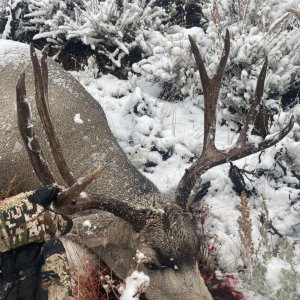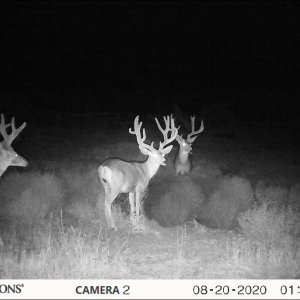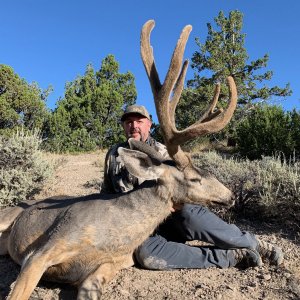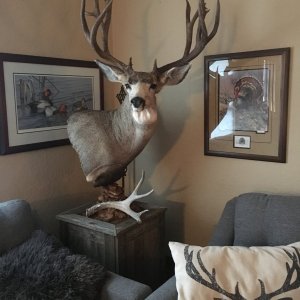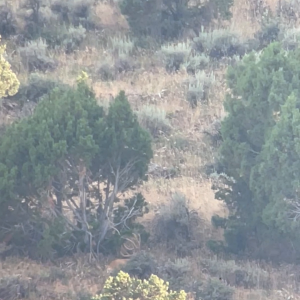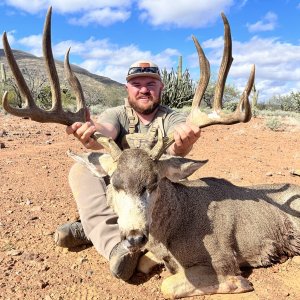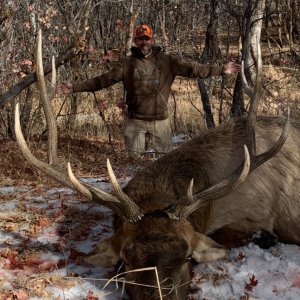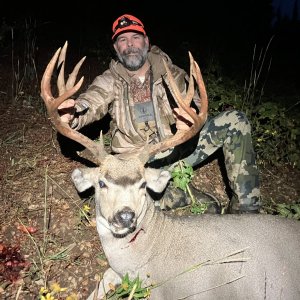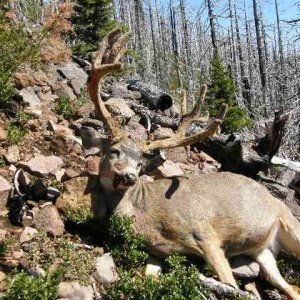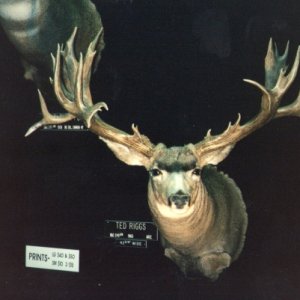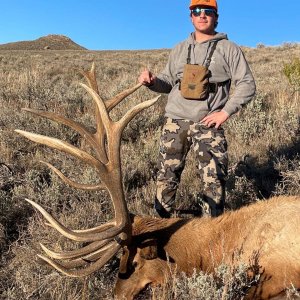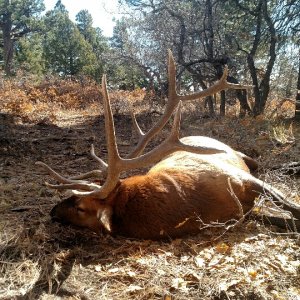This is off the Arizona Fish and Game site and should help:
White-tailed Deer
Overview: Whitetail hunting throughout the unit is good. Habitat conditions resulting from near average rainfall amounts during 2001 allowed fawn survival to improve over past years. Therefore, the number of 1-2 year old bucks entering the population should be quite high, resulting in good harvest success. Unfortunately, the winter, spring, and summer of 2002 has resulted in below average precipitation causing poor habitat conditions. It is predicted that 2002-2003 fawn recruitment will be well below average. Even though the overall whitetail population has declined, due to drought conditions, over the past 6-7 years, bucks are still available in good numbers throughout the Huachuca Mts., Canelo Hills and Mustang Mts. Trophy quality bucks are still available, but hunters must be persistent and patient if they expect to harvest one of these elusive animals.
Area: Take I-10 to Hwy 90, south to Sierra Vista allowing access to the east side of the Huachucas. I-10 to Hwy 83 to Sonoita, east on Hwy 82 to Mustang Mts. or south on Hwy 83 to Canelo Hills and west side of Huachuca Mts.
Access can be obtained by purchasing USFS maps. Additionally, state land and topographical maps are helpful.
As with all hunting, scouting is important to a successful hunt. With whitetail hunting, scouting is a prerequisite if one wants to put the percentages in his favor. If a mature buck is your goal, any hunt can produce a trophy but knowing the area and the habits of your buck are paramount to success.
The range of the mule deer overlaps that of the whitetail. Every year some hunter accidentally harvests the wrong species. Therefore, it is important to accurately identify the buck to species, prior to shooting. The only reliable means of identification is the tail. The mule deer tail is narrow and black tipped at the end. The whitetail is broad, long and gray/brown in coloration. When alarmed, whitetail will sometimes lay their tail on their back, or flag, showing a white underside and a white rump. It is important to note that not all whitetail will flag. Therefore, if not absolutely sure of which species you are looking at, do not shoot. Also, remember that one characteristic alone is not a totally reliable means of identifying a whitetail from a mule deer. For further information, along with illustrations identifying differences between whitetail and mule deer, please review the 2002-2003 Arizona Hunting Regulations.
Hunting the Coues whitetail entails owning a quality pair of optics and knowing how to use them. Whitetail, inhabit all habitat types found throughout the units, particularly the oak-juniper woodlands. They do not venture long in open areas. Rather, they remain secluded in the woodlands. Therefore, it is imperative for the successful hunter to locate an adequate vantage point and glass diligently for long periods of time. The adage of glassing more than you walk is paramount in successfully locating whitetail. Look for parts of the deer rather than the entire animal while glassing. It is also helpful to arrive at your vantage point well before first light and remain in the field until dark. Whitetail, are active at first light and at dusk but also can be found feeding and moving to shaded bed sights during the middle of the day.
During the early archery season glass from high vantage points at first light looking for feeding bucks. Observe, until the buck beds and air currents stabilize, then attempt a stalk. Unlike their eastern cousins, Coues whitetail do not pattern well, but water holes and deer trails can be productive, particularly during dry periods.
The October general firearm hunt usually finds the whitetail in the lower elevations and foothills. Active periods are early, middle and late in the day, as temperatures are still fairly warm.
The November hunt will usually find the bucks moving out of the bottoms and working up the mountains, preparing for the rut. Weather conditions vary from warm in the day to cold at nights.
The December hunt finds weather conditions more to the deer's liking, and as the rut nears, they become more active for longer periods of time. The younger bucks are the first to accompany does. The mature bucks will be in the vicinity, but do not venture far from thick cover. Harvesting a mature buck takes luck, skill and determination.
The January archery hunt is the ideal time to locate mature bucks chasing does, since the peak of the rut begins sometime during the middle of the month. Since the bucks are constantly on the move, chasing or looking for does, it is often times difficult to locate the buck during the final stalk. During this time, grunt calls and rattling can prove effective.
NOTES: The Coronado National Memorial administered by the National Park Service is located at the Southeast end of the Huachuca Mountains. It is closed to hunting and the taking of any wildlife species. Additionally, all weapons, including archery equipment, must be cased, unloaded and incapable of being readily discharged while traveling through the memorial. For further information phone (520) 458-9333 or 366-5515.
The possession or use of motorized vehicles off forest system roads and trails is prohibited. This law is also pertinent to all public lands, as well as, private lands if permission from the landowner has not first been obtained. Off road travel in washes is not allowed unless the wash is part of an existing road. For further information concerning this or any other laws administered by the USFS contact the Coronado National Forest, Sierra Vista Ranger District at 5990 S. Highway 92, Hereford, AZ 85615. Phone (520) 378-0311.
Prior to accessing or hunting lands owned by the Babocomari Ranch, contact the ranch manager at (520) 455-5507.
The National Audubon Research Ranch is located within the unit. Much of this is private and closed to hunting. For further information call (520) 455-5522.
Some areas within the San Pedro riparian area are closed to the use of firearms. For information relating to BLM lands along the San Pedro River contact the BLM Sierra Vista office: San Pedro RNCA, 1763 Paseo San Luis, Sierra Vista, AZ 85636. Phone (520) 458-3559.

